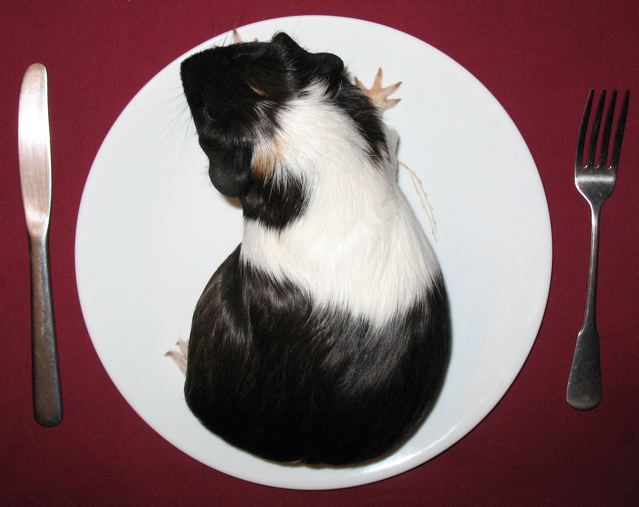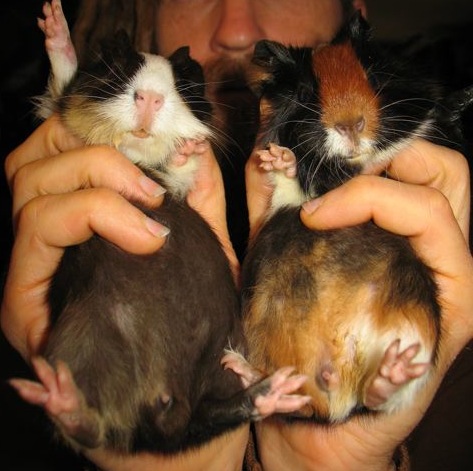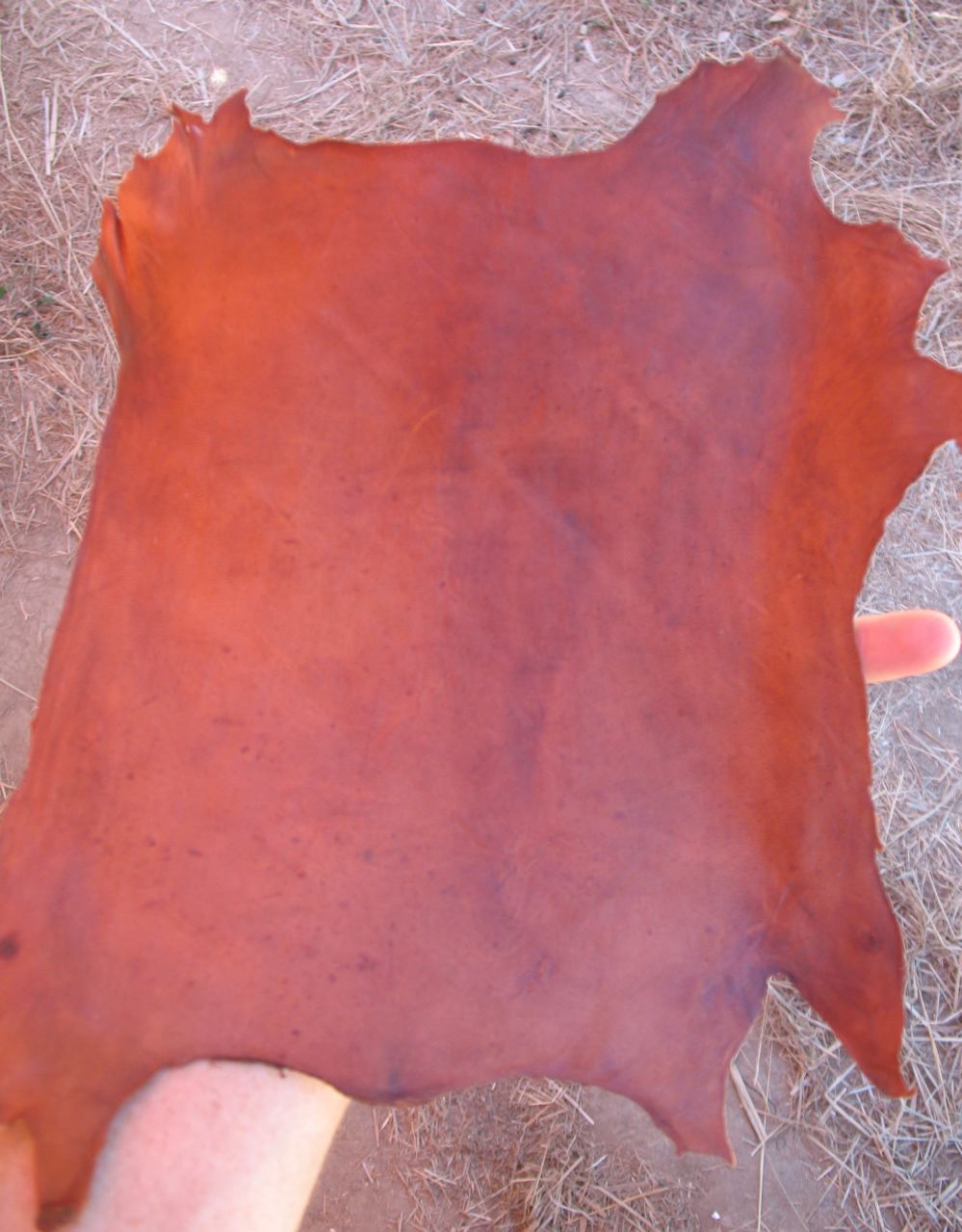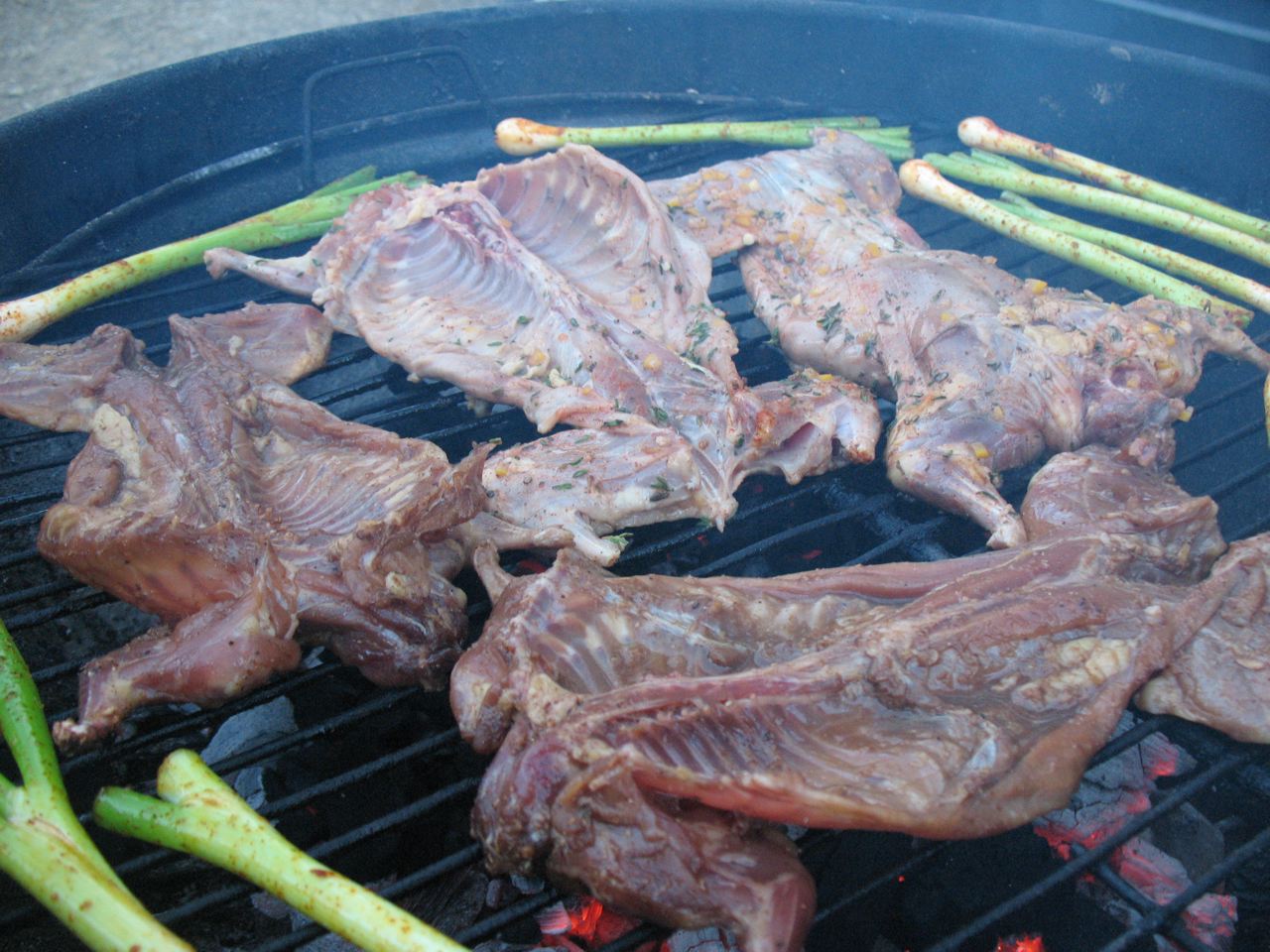an experiment in raising guinea pigs for food begins in the remote and beautiful mountains of Northern California. Caressed by the sun, nurtured by the rain and lulled by the gentle song of the turkey, they grow fat and tasty in the...........

I became interested in Guinea Pigs as a possible source of meat a year or two ago. For anyone who doesn't already know, they are a popular source of meat in parts of South America. My initial impression was that they are much like rabbits, but maybe more able to live on the stream of unused leaves, vegetable peelings and just general vegetable surplus that flows from the garden than rabbits are. Also, unlike rabbits, they aren't diggers and they don't climb out of things over a foot high. My breeding pair have so far lived largely in cardboard boxes that they could clearly get out of, but they really don't even want to. Give them some food and some place to hide and they're not going anywhere! I'm totally unclear on the feed to growth ratio of guinea pigs as compared to rabbits, but I'm hopeful, and if most of the food is scraps, it may not matter that much. For these reasons they seem like a fairly ideal small livestock for certain situations, especially urban and suburban environments. They could probably mow the lawn.
I've actually found them to be a little picky about food which was initially disappointing. At first they were interested only in hay and fresh grass. Then I got them to nibble on some carrot greens and that soon became their favored food. Then they got into the carrots themselves and parsley and cilantro. Now they like lettuce and will eat apple or pear and some other stuff depending on how hungry they are... and the female is about to give birth, so she's always hungry! They are pretty much not into Kale, tree collards and other brassica leaves, but will eat them if hungry. That's too bad as I always have a lot of that stuff as garden surplus. I think if they were raised to other feed as youngsters that they would eat, and like, a more diverse diet.
Anyway, guinea pigs don't dig and they don't climb which should make them better candidates for use in arks or tractors than rabbits. (As in chicken tractor: a moveable bottomless cage which allows the animals to forage on the ground without getting away or getting eaten). So far, my guineas are in the guinea tractor during warm days when we're around and live in cardboard boxes the rest of the time. I'd like to leave them in the tractor(s) all day and night all year long, but there are problems that need to be taken into account. Guinea pigs allegedly can't live on wire cage bottoms or their toes will get caught and injured or torn off. Even if they could, the wire would compress the grass so that they couldn't feed on it.. at least not as easily. With no wire bottom though, predators could dig under easily enough. I thought of putting a locking house inside the tractor that you close each night to lock them in, but I'm not sure that would be adequate. At this point I'm thinking of going electric. Either by electrifying the whole cage or by running a few wires around the outside. Potential problems with the electric guinea pig tractor scenario are snakes crawling under the cage without getting shocked, figuring out how to have the electric wire or fencing high enough to avoid it's shorting out on grass and weeds, but low enough to shock low profile animals that might want to dig under. It's hard to say how high that is without trying it, so I think it's an experiment that just needs to be jumped into.
Conventional wisdom says that guinea pigs are vulnerable to rapid changes in temperature and in general to cold, wind, heat, wet, etc... So, I think a full cover is in order on the whole tractor I'm also thinking that it would be good to have an easy way to put up wind/sun screens on the sides, or let air circulate depending on the weather. Certainly a house of some kind that is insulated and which they can heat with their bodies will be necessary here where it can get cold, damp, rain torrents, and sometimes snow. If the house is above ground level, they can still forage beneath it and use it as a low ceilinged place to hang out and feel safe, which they really like and probably need in order to not feel neurotic. So, you see, I have half a plan for a guinea pig tractor that needs building and plenty of projects and stuff to get in the way of building it! Oh yeah, and as soon as the female gives birth, which is imminent, I need to keep them separate so they don't have a big 'ol incest party in there. So, I guess I will end up needing numerous guinea pig tractors, or at least dividers... hmmmm.... this is getting complicated.
I hope guinea pigs are tasty, I've never eaten one, but millions of peruvians can't be wrong! In the meantime I'm looking for the biggest breeders I can find My male is almost 2 1/2 pounds, but that's still pretty small. A university in peru is supposed to have bred jumbo guineas, but I don't know if they are available in the states. I'd sure like to get me a coupla them ones.
UPDATE 1/4/10: The guineas are now moved out of cardboard boxes and into a pen made of strawbales with a changeable cardboard floor. I put "litter boxes" in the pen, but they seem to pee along all edges of the pen just as often as in the boxes. Too bad as that complicates housing. I'm interested to know how Peruvians who keep them in the house deal with the waste problem. They pee an awful lot! The male tried to breed the female as soon as she gave birth. I mean immediately! The babies were a wet pile in the corner of the box and he was all over her. I had to move him into a separate box with extra high walls as he kept jumping out trying to get to her. The babies are growing fast. A couple times they were measured growing 1/2 ounce in 48 hours. I don't know if that has continued or if it will slow or speed up since measurements have been erratic. Re-thinking the guinea pig tractor idea I'm pretty sure that a closed "house" with a floor would have to be cleaned out since they don't seem prone to toilet training. I don't want to clean anything. The ideal is that they can be on the ground where they do their business and are moved about once a day for new grazing. I'm also inclined to try to avoid the electric cage idea as it's just more industrially produced stuff that is prone to breakage. So it's back to the drawing board to figure out how to keep predators at bay.
UPDATE: AUGUST 16TH 2010
Now that the guinea pig experiment has come to a close, I wanted to type an update. Guinea pigs are tasty. As predicted, millions of peruvians aren't wrong! They also grow very slowly. Actually, that's not entirely true. Mine grew very fast up to about 1 pound. I was actually excited by their rapid growth... at first. After a pound they slowed to a snails pace. A reasonable rule of thumb for animals is that about 1/3 of their body weight is edible. So, that means not a whole lot of meat on a 1 pound pig. One day the cat caught a squirrel which we traded him some dry food for. Squirrels are great eating and at about the same size, catching them is easier than raising a guinea pig for a couple/few months, so the light bulb sort of went on there. I'd rather go squirrel hunting with my pellet rifle than change a guinea pig cage or whatever other domestic chore is occasionally required.
The work of raising cuy, and the small return might be Ok in some instances though. There is a time/place/context for raising guinea pigs as a food source. They live mostly off scraps from the garden, and now that they are gone that niche is no longer filled on this homestead. The essence of what I learned in this experiment is basically that if the relationship between the cuy and people were a low maintenance one, they could have a place for situations in which there is a steady stream of vegetable scraps and or surplus hay to feed them. Not that I didn't already know that, but now I know more about their needs and wants and abilities, enough to possibly design them in somewhere. There are things they won't eat and things they'd rather not eat, but they do eat most of the stuff that comes from the garden. Various frineds and visitors have offered their stories and experiences regarding how guinea pigs are integrated into households in South America. It sounds like they are pretty well integrated, even into the architecture, to the point that they are very low maintenance. If I could basically have them safe from predators and toss or drop food to them directly from the kitchen, or at least have them close to the kitchen I could see this relationship working. But, the way we were doing it here they were too high maintenance. Moving them in at night to foil predators, cleaning boxes, changing bedding, moving the guinea pig tractor, remembering anniversaries, back rubs....... for something that small which grows slowly? No thanks. I will have the cute, entertaining and tasty guinea pig in mind as I'm designing and building around here, because I could see them having a place, but for now they were too much work for not enough return... even considering the entertainment value and conversation magnet of small squeaky fuzzy animals.
I gave the guinea pig tractor idea a lot of thought, but it just didn't seem workable here. Besides, it still has to be moved. And there is a limited window of time in this Mediterranean climate when fresh green vegetation is really available for them to eat anyway. Predators and moving the tractor were the two main issues there. I think the type of infrastructure that would be required for a predator safe low maintenance free range-ish system would also house rabbits just as well and they grow faster... then again, maybe they could coexist just for variety and diversity and shit like that.
So what do guinea pigs taste like? drum roll please............ they taste like guinea pigs, which taste good.
I haven't made anything out of them yet, but the skins are remarkably thick and durable feeling. I tanned 5 of them with oak bark and the hair removed. Don't ask me what I'm going to make with them because I don't know yet. I expected a thin and weak skin, but they seem dense fibered and thick in proportion to their size.... much like grey squirrel skins. Here is an admittedly somewhat blurry picture of the skin tanned with tanoak bark.
I enjoyed keeping Guinea Pigs in many respects, but I'm not a big animal nurturer at heart, so the labor/return ratio soon became a total buzz kill. When a friend came over to eat them with us, he had a moment of sadness while tossing some carrot greens into the compost. I too have had the sense of loss that our lively little vegetable disposal system is no longer with us and with it the realization that this is a good niche to have filled. But, every organism needs a place and the guinea pig is a very domesticated animal. Millennia of having a dependent relationship with humans leaves the guinea pig unable to care for itself and in need of proper housing and care. That is the guinea pig's place and for us to provide that we need returns that work for us. If and when we can achieve the goal of an elegant integration into our lives through proper infrastructure and behavioral systems, guinea pig may yet find it's traditional place in our houses, in our hearts and on our plates.
Guinea Pig munch off!
http://www.youtube.com/watch?v=vGqF63c6LZw






